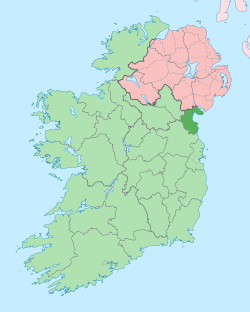Drogheda
Drogheda (/ˈdrɒhədə, ˈdrɔːdə/ DRAW-həd-ah; Irish: Droichead Átha [ˈd̪ˠɾˠɛhəd̪ˠ ˈaːhə], meaning "bridge at the ford") is one of the oldest towns in Ireland. It is located on the Dublin–Belfast corridor on the east coast of Ireland, mostly in County Louth but with the south fringes of the town in County Meath, 49 km or 30 miles north of Dublin. Drogheda has a population of approximately 41,000 inhabitants (2016), making it the eleventh largest settlement by population in all of Ireland. It is the last bridging point on the River Boyne before it enters the Irish Sea. The UNESCO World Heritage Site of Newgrange is located 8 km west of the town.
.jpg)
Drogheda Droichead Átha | |
|---|---|
 2007 view of Drogheda from the south | |
 Flag 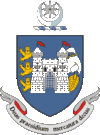 Coat of arms | |
| Motto(s): “God our strength, merchandise our glory.” | |
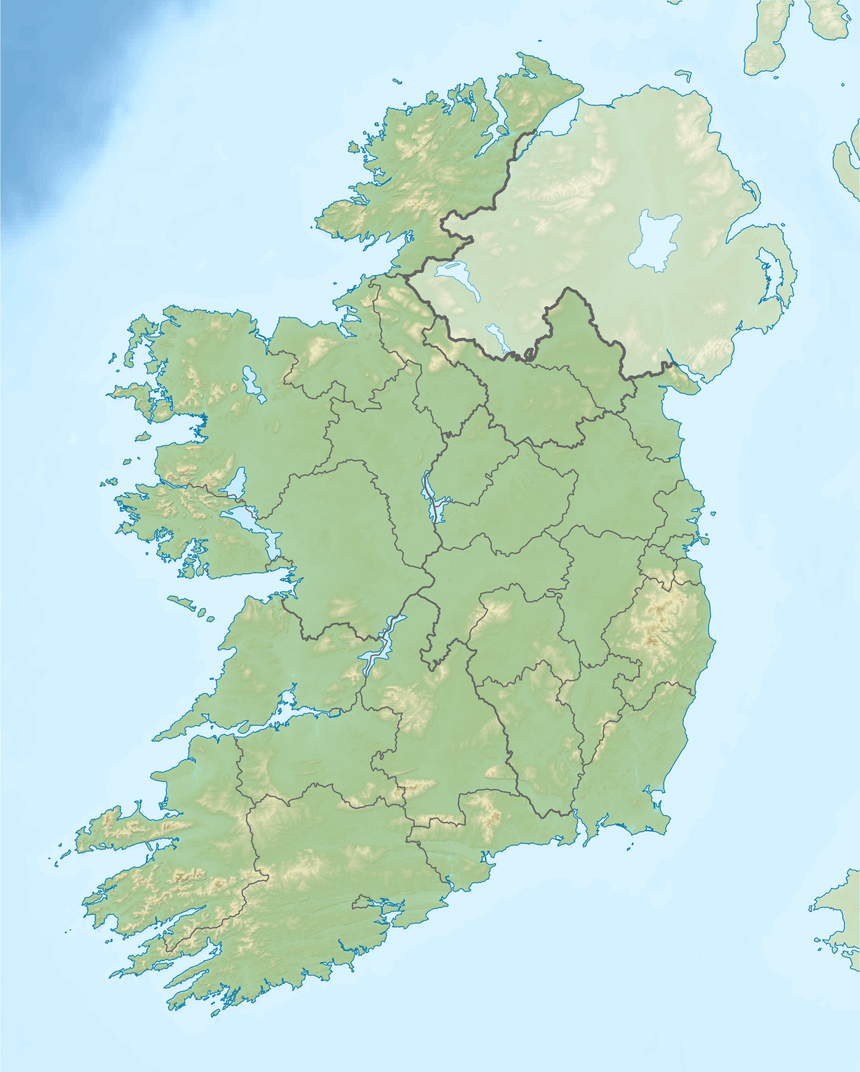 Drogheda Location in Ireland  Drogheda Drogheda (Europe) | |
| Coordinates: 53.714°N 6.350°W | |
| Country | Ireland |
| Province | Leinster |
| County | County Louth and County Meath |
| Municipal district | Drogheda Borough District |
| Dáil Éireann | Louth |
| EU Parliament | Midlands–North-West |
| Founded | 911 AD |
| First Charter | 1194 |
| County Status | 1412[1] (Abolished 1898) |
| Area | |
| • Total | 14.8 km2 (5.7 sq mi) |
| Highest elevation | 24 m (79 ft) |
| Lowest elevation | 1 m (3 ft) |
| Population (2016)[2] | |
| • Total | 40,956 |
| • Rank | 6th |
| • Density | 2,776.6/km2 (7,191/sq mi) |
| • Greater area | 83,000[3] |
| Demonyms | Droghedean, Boynesider |
| Time zone | UTC±0 (WET) |
| • Summer (DST) | UTC+1 (IST) |
| Eircode routing key | A92 |
| Telephone area code | +353(0)41 |
| Website | www |
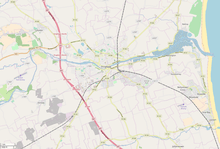
Drogheda was founded as two separately administered towns in two different territories: Drogheda-in-Meath (i.e. the Lordship and Liberty of Meath, from which a charter was granted in 1194) and Drogheda-in-Oriel (or 'Uriel', as County Louth was then known). The division came from the twelfth-century boundary between two Irish kingdoms, colonised by different Norman interests, just as the River Boyne continues to divide the town between the dioceses of Armagh and Meath. In 1412 these two towns were united, and Drogheda became a 'County Corporate', styled as 'the County of the Town of Drogheda'. Drogheda continued as a County Borough until the setting up of County Councils through the enactment of the Local Government (Ireland) Act 1898, which saw all of Drogheda, including a large area south of the Boyne, become part of an extended County Louth. With the passing of the County of Louth and Borough of Drogheda (Boundaries) Provisional Order, 1976, County Louth again grew larger at the expense of County Meath. The boundary was further altered in 1994 by the Local Government (Boundaries) (Town Elections) Regulations 1994. The 2007–2013 Meath County Development Plan recognises the Meath environs of Drogheda as a primary growth centre on a par with Navan.
The town was selected to host Fleadh Cheoil na hÉireann for two years in 2018.[4]
History

Hinterland
| Year | Pop. | ±% |
|---|---|---|
| 1811 | 15,590 | — |
| 1813 | 16,123 | +3.4% |
| 1821 | 18,118 | +12.4% |
| 1831 | 17,365 | −4.2% |
| 1841 | 17,300 | −0.4% |
| 1851 | 16,810 | −2.8% |
| 1861 | 14,722 | −12.4% |
| 1871 | 13,510 | −8.2% |
| 1881 | 12,297 | −9.0% |
| 1891 | 11,873 | −3.4% |
| 1901 | 12,760 | +7.5% |
| 1911 | 12,501 | −2.0% |
| 1926 | 12,716 | +1.7% |
| 1936 | 14,494 | +14.0% |
| 1946 | 15,715 | +8.4% |
| 1951 | 16,779 | +6.8% |
| 1956 | 17,008 | +1.4% |
| 1961 | 17,085 | +0.5% |
| 1966 | 17,908 | +4.8% |
| 1971 | 20,095 | +12.2% |
| 1981 | 23,615 | +17.5% |
| 1986 | 24,681 | +4.5% |
| 1991 | 24,656 | −0.1% |
| 1996 | 25,282 | +2.5% |
| 2002 | 31,020 | +22.7% |
| 2006 | 35,090 | +13.1% |
| 2011 | 38,578 | +9.9% |
| 2016 | 40,956 | +6.2% |
| [5] | ||
The town is situated in an area which contains a number of archaeological monuments dating from the Neolithic period onwards, of which the large passage tombs of Newgrange, Knowth, and Dowth are probably the best known.[6] The density of archaeological sites of the prehistoric and early Christian periods uncovered in the course of ongoing developments, (including during construction of the Northern Motorway or 'Drogheda Bypass'), have shown that the hinterland of Drogheda has been a settled landscape for millennia.[7][8]
Town beginnings
Despite local tradition linking Millmount to Amergin Glúingel, in his 1978 study of the history and archaeology of the town John Bradley stated that "neither the documentary nor the archaeological evidence indicates that there was any settlement at the town prior to the coming of the Normans".[9] The results of a number of often large-scale excavations carried out within the area of the medieval town appear to confirm this statement.[10]
One of the earliest structures in the town is the motte-and-bailey castle, now known as Millmount Fort, which overlooks the town from a bluff on the south bank of the Boyne and which was probably erected by the Norman Lord of Meath, Hugh de Lacy sometime before 1186. The wall on the east side of Rosemary Lane, a back-lane which runs from St. Laurence Street towards the Augustinian Church is the oldest stone structure in Drogheda.[11] It was completed in 1234 as the west wall of the first castle guarding access to the northern crossing point of the Boyne. The earliest known town charter is that granted to Drogheda-in-Meath by Walter de Lacy in 1194.[12] In the 1600s, the name of the town was also spelled "Tredagh" in keeping with the common pronunciation, as documented by Gerard Boate in his work Irelands' Natural History. In c. 1655 it was spelled "Droghedagh" on a map by William Farriland.[13]
Drogheda was an important walled town in the English Pale in the medieval period. It frequently hosted meetings of the Irish Parliament at that time. According to R.J. Mitchell in John Tiptoft, Earl of Worcester, in a spill-over from the War of the Roses the Earl of Desmond and his two youngest sons (still children) were executed there on Valentine's Day 1468 on orders of the Earl of Worcester, the Lord Deputy of Ireland. It later came to light (for example in Robert Fabyan's The New Chronicles of England and France), that Elizabeth Woodville, the queen consort, was implicated in the orders given.[14] The parliament was moved to the town in 1494 and passed Poynings' Law, the most significant legislation in Irish history, a year later. This effectively subordinated the Irish Parliament's legislative powers to the King and his English Council.
Later events
.jpg)
The town was besieged twice during the Irish Confederate Wars.
On the second occasion an assault was made on the town from the south, the tall walls breached, and the town was taken by Oliver Cromwell on 11 September 1649,[15] as part of the Cromwellian conquest of Ireland and it was the site of a massacre of the Royalist defenders. In his own words after the siege of Drogheda, "When they submitted, their officers were knocked on the head, and every tenth man of the soldiers killed and the rest shipped to Barbados."[16]
The Earldom of Drogheda was created in the Peerage of Ireland in 1661.
The Battle of the Boyne, 1690, occurred some 6 km (3.7 mi) west of the town, on the banks of the River Boyne, at Oldbridge.
In 1790, Drogheda Harbour Commissioners were established. They remained in place until 1997 when the Drogheda Port Company a commercial enterprise replaced them.
In 1825, the Drogheda Steam Packet Company was formed in the town, providing shipping services to Liverpool.
In 1837, the population of Drogheda area was 17,365 people, of whom 15,138 lived in the town.[17]
Town arms
Drogheda's coat of arms features St. Laurence's Gate with three lions, and a ship emerging from either side of the barbican. The town's motto Deus praesidium, mercatura decus translates as "God our strength, merchandise our glory".
The star and crescent emblem in the crest of the coat of arms is mentioned as part of the mayor's seal by D'Alton (1844).[18] In 2010, Irish president Mary McAleese, in a speech delivered during an official visit to Turkey, stated that the star and crescent had been added in the aftermath of the Great Famine as gratitude for food supplies donated by the Ottoman Sultan, which had arrived at Drogheda by ship. Irish press quickly pointed out the story was a myth, with a local historian calling it 'nothing short of sheer nonsense'.[19][20] However, later evidence, including a letter displayed at the office of the European Commission, confirms that Turkey came to the aid of the Irish during the Famine.[21][22]
20th century

In 1921, the preserved severed head of Saint Oliver Plunkett, who was executed in London in 1681, was put on display in St. Peter's (Catholic) Church, where it remains today. The church is located on West Street, which is the main street in the town.
In 1979, Pope John Paul II visited Drogheda as part of his five-stop tour of Ireland. He arrived less than a month after the IRA assassination of Lord Mountbatten, Queen Elizabeth's cousin, in Mullaghmore. On 29 September 1979, he arrived in Dublin, where he gave his first mass. He then addressed 300,000 people in Drogheda, where he appealed "on his knees" to paramilitaries to end the violence in Ireland:[23][24][25]
"Now I wish to speak to all men and women engaged in violence. I appeal to you, in language of passionate pleading. On my knees I beg you to turn away from the paths of violence and to return to the ways of peace. You may claim to seek justice. I too believe in justice and seek justice. But violence only delays the day of justice. Violence destroys the work of justice. Further violence in Ireland will only drag down to ruin the land you claim to love and the values you claim to cherish."[26]
21st century
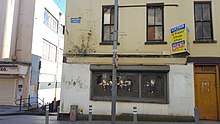
Two decades into the 21st century some of the historic core of Drogheda town has suffered urban decline. Some of the buildings have been derelict for some years and are in danger of collapse.[27] There was a 2006 traffic plan for pedestrianisation of West Street. It was rejected at a vote of the elected councillors. They had come under pressure from traders in the area concerned about a potential further decline in customer footfall. But the issue has come up for debate again.[28] When asked, Drogheda residents point out that a combination of expensive car-parking and high commercial rates had a push-pull effect on the town's centre. Shops were forced to close and at the same time shoppers brought their business to retail parks such as the Boyne Shopping Centre on Bolton Street.[29] A substantial root-and-branch approach to renewal of the locality was proposed in “Westgate Vision: A Townscape Recovery Guide”. The Westgate area of Drogheda is to be subject to a 10-year regeneration by Louth County Council.[30]
Demographics
Drogheda has a hinterland of 70,000+ within a 15 kilometres (9.3 mi) radius covering County Louth and County Meath. According to the 2016 census, there were 40,956 people living in Drogheda town at that time.[31]
As of the 2011 census, non-Irish nationals accounted for 16.1% of the population, compared with a national average of 12%. Polish nationals (1,127) were the largest group, followed by Lithuanian nationals (1,044 people).[32] As of the 2016 census, 17.4% of the population were non-Irish nationals, with 676 people from the UK, 1,324 Polish nationals, 1,014 Lithuanians, 1,798 people from elsewhere in the EU, and 1,400 with other (non-EU) nationalities.[31]
Arts and entertainment
Music
Drogheda has hosted the national traditional music festival, Fleadh Cheoil na hÉireann, in 2018 and again in 2019.[33]
Drogheda is home to two brass bands: Drogheda Brass Band and Lourdes Brass Band. Both bands have been National Brass Band Champions of Ireland and Northern Ireland.
The town previously hosted a summer Samba festival in which Samba bands from around the world came to the town for three days of drumming and parades.[34]
Literature
Drogheda and its hinterland have had a strong literary tradition. Oisín McGann is an award-winning writer of children's literature. Angela Greene was the first Drogheda poet to win The Patrick Kavanagh Poetry Award in 1988. The Drogheda poet Susan Connolly was awarded the Patrick and Katherine Kavanagh Fellowship in Poetry in 2001 for her life's work. The poet, writer, and occasional broadcaster Marie MacSweeney has received the Francis MacManus Short Story Award for her short story Dipping into the Darkness.
Places of interest

Drogheda is an ancient town that has a growing tourism industry.[35] It has a UNESCO World Heritage site, Newgrange, located 8 kilometres (5.0 mi) to the west of the town centre. Other tourist sites in the area include:
- Millmount Fort and museum
- Saint Laurence Gate barbican gate c. 1300s
- John Philip Holland memorial (sculpture commemorating submarine inventor)
- Boyne Viaduct
- John Jameson's residential home (not open to the public), and a Jameson distillery trail of malthouses in the town.
- Battle Of The Boyne Site, visitors centre
- Eamonn Ceannt's school (formerly St Joseph's CBS now operates as Scholars Hotel)
- Beaulieu House and gardens
- Mellifont Abbey
- Townley Hall nature trail and woods
- Princess Grace Rose Garden at St. Dominic's Park
- St. Peter's Roman Catholic Church, which houses a shrine of Oliver Plunkett
- St Peter's Church of Ireland church, on Peter's Hill
- Highlanes Gallery
- Augustinian Church [36]
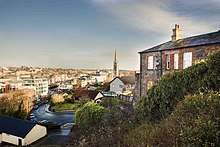
Industry and economy
Drogheda has a growing industrial base with several international companies based in the town. Local employers include the Boyne Valley Group (food producers), Coca-Cola International Services, State Street International Services, Natures Best (a food processor employing 300 people),, Yapstone Inc,[37][38] the Drogheda Port Company (the oldest indigenous employer since 1790), Glanbia, Flogas, and CRH plc.
Drogheda also has a history of brewing and distilling, with companies Jameson Whiskey, Coca-Cola, Guinness, Jack Daniel's all having previously produced (or are still producing) their products in or near the town. These include the Boann distillery and brewery, Slane Whiskey (a Jack Daniel's-owned company), Listoke House, Dan Kellys (cider), and Jack Codys (craft beers and stouts). The town formerly distilled Prestons whiskey, a Jameson Whiskey brand; Carines Beer, founded locally and sold to Guinness; and Coca-Cola concentrate, which has since moved to Ballina, County Mayo.
Transport, communications and amenities
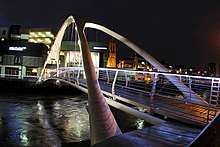
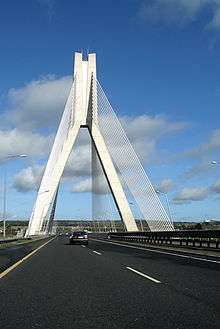
Road links and infrastructure
Drogheda is located close to the M1 (E1 Euro Route 1) (main Dublin – Belfast motorway). The Boyne River Bridge carries traffic from the M1, across the River Boyne, 3 km west of the town. It was opened on 9 June 2003 and is the longest cable-stayed bridge in Ireland. The town's postcode, or eircode, is A92.
Railway
Drogheda acquired rail links to Dublin in 1844, Navan in 1850 and Belfast in 1852. Passenger services between Drogheda and Navan were ended in 1958, however the line remains open for freight (Tara Mines/Platin Cement) traffic. In 1966 Drogheda station was renamed "MacBride". Drogheda railway station opened on 25 May 1844.[39]
The station has direct trains on the Enterprise northbound to Dundalk, Newry, Portadown, Lisburn and Belfast Central, and southbound to Dublin Connolly.
A wide variety of Iarnród Éireann commuter services connect southbound to Balbriggan, Malahide, Howth Junction, Dublin Connolly, Tara Street, Dublin Pearse, Grand Canal Dock, Dún Laoghaire, Bray, Greystones, Wicklow, Rathdrum and Arklow.
Bus transport
Drogheda's bus station is located on Donore Road. It replaces an earlier facility on the Bull Ring. Past Bus Éireann routes included the 184 to Garristown and 185 to Bellewstown but these were discontinued a few years ago.
Politics and government
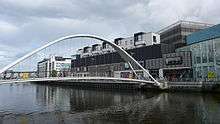
Drogheda Borough Council is an elected local government body which is mandated under the Local Government Act 2001 to provide civic leadership and a forum for the democratic representation of the community. Responsibilities include amenity support, operation of the Litter Act, contribution to tourism development, event licensing, arts support, etc. The Borough Council executive comprises twelve elected Councillors, headed by the mayor. The mayor, elected in June 2019 for the period 2019–2020, was Paul Bell (Labour).[40]
For local elections to Louth County Council, the town forms part of two local electoral areas – Drogheda East (6) and Drogheda West (4) . This includes both the urban Drogheda area and surrounding rural areas.
For the purposes of elections to Dáil Éireann, the town is part of the Louth constituency which returns five TDs.
Media
The local newspapers are the Drogheda Independent and Drogheda Leader, known locally as The D.I. and The Leader. Both newspapers are published every Wednesday. The headquarters of The Drogheda Independent are on Shop Street and The Drogheda Leader's offices are on Laurence Street.
The local radio station is LMFM, broadcasting on 95.8 FM. The headquarters of LMFM are on Marley's Lane on the south side of the town.
Hospitals and health care
Drogheda is a regional centre for medical care. Its main hospital is Our Lady of Lourdes Hospital, a public hospital located in the town. and is part of the Louth Meath Hospital Group. Facilities include a 24-hour emergency department for the populations of County Louth, County Meath and the North-East of Ireland. The hospital provides 340 beds, of which 30 are reserved for acute day cases.[41]
The Cottage Hospital on Scarlet Street is a former maternity hospital, which subsequently became a Geriatric Unit for a number of years and is now a long-stay residential unit.
Education
There are six secondary schools situated in Drogheda. St. Joseph's secondary school in Newfoundwell is an all-boys school, as is St. Marys Diocesan School on Beamore Rd. The Sacred Heart School,[42] situated in Sunnyside Drogheda, is an all-girls school. The Drogheda Grammar school, located on Mornington Road, St. Oliver's Community College,[43] on Rathmullen Road, and Ballymakenny College, on the Ballymakenny Road, are co-ed schools. Our Lady's College,[44] in Greenhills is an all-girls school. There is also Drogheda Institute for Further Education (DIFE), a third-level college situated in Moneymore.
Sport
The town's association football (soccer) team, Drogheda United FC, won the FAI Cup for the first time in 2005. The club also won the Setanta Cup in 2006, and the League of Ireland for the first time in 2007.
In rugby union, the local Boyne RFC team was formed in 1997 from the amalgamation of Delvin RFC and Drogheda RFC. As of 2010, the men's 1st XV team were playing in the Leinster J1 1st division. Drogheda is also home to a number of rugby-playing schools.
There are five Gaelic Athletic Association clubs in Drogheda: Newtown Blues GFC, Wolfe Tones GFC, O'Raghallaigh's GFC, Oliver Plunket's GFC, and St. Nicholas's GFC.
Town twinning




Notable residents and citizens
Arts and media
- Yasmine Akram, comedian and actress in Sherlock
- Pierce Brosnan, actor, film producer and environmentalist was born in Drogheda.
- Eamonn Campbell, member of The Dubliners
- James Chadwick,theologian, lyricist and Archbishop Newcastle and Hexham.
- Angela Greene, poet, Patrick Kavanagh Award 1988, Salmon Press.
- Alison Comyn, journalist and broadcaster
- Susan Connolly, poet, Patrick and Katherine Kavanagh Fellowship 2001
- Michael Holohan, composer, member and former chair of Aosdána
- Jonathan Kelly, singer-songwriter.
- Courtney Love singer actress and wife of Kurt Cobain[45][46]
- Colin O'Donoghue, actor known for his role of Captain Hook/Killian Jones in the American TV Show Once Upon a Time.
- Deirdre O'Kane, actress and casting director
- Eliza O'Neill, actress.
- John Boyle O'Reilly, poet and novelist, member of the Irish Republican Brotherhood
- Nano Reid, painter of landscapes, particularly Drogheda, the Boyne Valley and surrounding areas.
- Fiachra Trench, composer. Penned the string arrangement for fairytale of New York wrote music for many Hollywood movies.
Politics and diplomacy
- Geraldine Byrne Nason diplomat, Irish Ambassador to the United Nations
- Eamonn Ceannt 1916 Rising Leader - secondary school student in St Joseph CBS Drogheda.
- William Hughes, Irish-born US senator from New Jersey.
- Alison Kelly, Irish ambassador to Israel.
- Tony Martin, Canadian social democratic legislator.
- Dominic McGlinchey, INLA leader, assassinated 10 February 1994.
- John Neary Diplomat. Ambassador to Netherlands
- Damien English
- Peadar Toibin
- Henry Singleton, judge and friend of Jonathan Swift, was a lifelong resident of Drogheda.
- T. K. Whitaker, former Irish economist who wrote the Programme for Economic Expansion[47]
Military
- John Barrett Captain of HMS Minotaur (1793) and HMS Africa (1781)
- William Kenny, recipient of the Victoria Cross
- Rear-Admiral James Figgins[48] Captain of HMS Newcastle (C76) .WW2
- Thomas Charles Wright Admiral and Genera A founder of the Ecuadorian Navy/
- George Forbes, 3rd Earl of Granard Naval Officer
Business
- John Jameson Founder of Jameson whiskey lived in Distillery House, Dyer Street.
Academia and science
- James Cullen, mathematician who discovered what are now known as the Cullen numbers.
- John Philip Holland, inventor of the modern-day submarine.
- Thomas McLaughlin ESB founder and first CEO. Built the Shannon Hydro Electric Plant.
- Michael Scott, architect who designed Busáras and the Abbey Theatre
Religion
- Patrick Curtis Archbishop of Armagh, Spymaster for the Duke of Wellington in the Peninsular War. No 1 on Napoleon's most wanted list.
- Thomas Lancaster, bishop, buried at St. Peter's Church
Sport
- Tommy Breen, Manchester United goalkeeper
- Gavin Brennan, midfielder for Warrenpoint Town, Drogheda United and Shamrock Rovers. Brother of footballer Killian Brennan.
- Killian Brennan, midfielder with several League of Ireland clubs, and winner of 3 League of Ireland's, 3 FAI Cup's and 5 League Cup's
- Tommy Byrne, former racing driver, raced briefly in Formula 1 in 1982[49][50]
- Tony Byrne, bronze medal winner for Ireland 1956 Summer Olympics in Melbourne in the lightweight division.
- Megan Campbell, Manchester City Left Back
- Jerome Clarke, former Drogheda United forward, earned one cap for the Republic of Ireland.
- Nick Colgan, goalkeeper for Chelsea, Hibernian and the Republic of Ireland.
- Barry Conlon, former Manchester City Striker
- Mick Fairclough, Former Irish International (English Premier League of that era )
- Paddy Gavin, former full-back for Dundalk, Doncaster Rovers and Republic of Ireland B
- Deirdre Gogarty, 1997 Women's International Boxing Federation (WIBF) Featherweight Title Champion.
- James Hand, footballer for Huddersfield Town
- Ian Harte, former footballer with several English clubs and the Republic of Ireland national football team.
- Gary Kelly, football player and charity campaigner.
- Colin Lowth, an Olympic swimmer who represented Ireland at the 2000 Summer Olympics in Sydney.
- David McAllister, midfielder for Sheffield United, Shrewsbury Town and Stevenage.
- Shane Monahan, Professional rugby player, Gloucester, Leinster, Munster, Connaught, Ireland U-21s International.
- Des Smyth, professional golfer, vice-captain on the winning Ryder Cup team in 2006.
- Steve Staunton, former Liverpool and Aston Villa defender and Republic of Ireland captain and manager was born there.
- Gary Tallon, midfielder for Mansfield Town.
- Kevin Thornton, midfielder Coventry and former Republic of Ireland under 21.
- Sean Thornton, midfielder Drogheda United and Republic of Ireland under 21 national team, former Sunderland Player of the Year.
Other
- Jill Meagher, crime victim.
- Sir John Lumsden, founder of St John Ambulance Ireland
Freedom of the Town
The following people have received the Freedom of the Town of Drogheda.
- Charles Stewart Parnell: 1884.[51]
- Éamon de Valera: 1933.
- Pope John Paul II: 29 September 1979.[52]
- John Hume: 14 May 2001.[53]
- Father Iggy O’Donovan: 23 October 2013.[54]
- Michael D. Higgins: 22 May 2015.[55]
- Seamus Mallon: 8 June 2018.[56]
- Geraldine Byrne Nason: 10 January 2020.[57]
- Mary Robinson.
See also
- List of abbeys and priories in Ireland (County Louth)
- List of towns and villages in Ireland
References
- Johnston, L. C. (1826). History of Drogheda: from the earliest period to the present time. Drogheda. p. 37.
- "Population Density and Area Size 2016 by Towns". Central Statistics Office (Ireland). Retrieved 13 December 2017.
- "Cromwell back at gates of Drogheda - demanding a city". Independent.ie. Retrieved 2 December 2017.
- "Drogheda to host Fleadh Cheoil". Irish Independent. 18 March 2017. Retrieved 11 July 2017.
- See http://www.cso.ie/census and http://www.histpop.org for post 1821 figures, 1813 estimate from Mason's Statistical Survey. For a discussion on the accuracy of pre-famine census returns see J.J. Lee "On the accuracy of the Pre-famine Irish censuses", Irish Population, Economy and Society, eds. J.M. Goldstrom and L.A. Clarkson (1981) p.54, and also "New Developments in Irish Population History, 1700–1850" by Joel Mokyr and Cormac O Grada in The Economic History Review, New Series, Vol. 37, No. 4 (Nov. 1984), pp. 473–488.
- Stout, G. 2002 Newgrange and the Bend of the Boyne. Cork University Press.
- Bennett, I. (ed) 1987–2004 Excavations : Summary accounts of archaeological excavations in Ireland. Bray.
- The Hidden Places of Ireland 190443410X David Gerrard - 2004 -"Two minutes from the centre of Drogheda. in the old townland of Mell."
- Bradley, J. 1978 'The Topography and Layout of Medieval Drogheda', Co. Louth Archaeological and Historical Journal, 19, 2, 98–127.
- Bennett op cit.
- Archaeology No. 5257: The medieval walls of Drogheda
- Bradley op cit 105
- NLI. MS. 716, copy of map by Daniel O'Brien, c. 1780
- Fabyan, Robert; Ellis, Henry (1811). The new chronicles of England and France, in two parts: by Robert Fabyan. Named by himself The concordance of histories. Reprinted from Pynson's edition of 1516. The first part collated with the editions of 1533, 1542, and 1559; and the second with a manuscript of the author's own time, as well as the subsequent editions: including the different continuations. To which are added a biographical and literary preface, and an index. Robarts - University of Toronto. London : Printed for F.C. & J. Rivington [etc.]
- Antonia Fraser, Cromwell, our chief of men (London, 1973)
- Cromwell letter to William Lenthall (1649)
- "Entry for Drogheda in Lewis Topographical Dictionary of Ireland (1837)". Libraryireland.com. Retrieved 20 November 2014.
- John D'Alton, The History of Drogheda: With Its Environs, and an Introductory Memoir of the Dublin and Drogheda Railway (1844), p. 138.
- Comyn, Alison (31 March 2010). "PRESIDENT SPARKS STAR AND CRESCENT DEBATE". Irish Independent.
- Murray, Ken (25 March 2010). "President tells Turks an anecdote of myth not fact". The Irish Times. Retrieved 25 March 2010. "Liam Reilly, an administrator with the Old Drogheda Society based in the town's Millmount Museum, said last night the comments were incorrect. 'There are no records with the Drogheda Port Authority of this ever happening. Drogheda historians can trace the star and crescent back to 1210 when the British governor of Ireland, King John Lackland, granted the town its first charter,' he said" "Ottoman aid to the Irish to hit the big screen". TodaysZaman. Archived from the original on 6 October 2014. Retrieved 20 November 2014."New evidence shows Turkey delivered food to Ireland during the famine". IrishCentral.com. Retrieved 20 November 2014.
- Murray, Ken (1 June 2010). "Role of Turkey during Famine clarified". The Irish Times.
- "Remembering Pope John Paul II's 1979 visit to Ireland (PHOTOS)". IrishCentral.com. 29 September 2016. Retrieved 17 June 2017.
- Doherty, Christine (6 January 2010). "Drogheda was safe place for Pope to visit". The Independent. Retrieved 17 June 2017.
- McGarry, Patsy (29 November 2016). "Pope's visit to Ireland will not draw the 1979 crowds of 2.7m". The Irish Times. Retrieved 17 June 2017.
- "29 September 1979: Mass in Drogheda - Dublin | John Paul II". Libreria Editrice Vaticana. Vatican. Retrieved 17 June 2017.
- "Dangerous structure notice is served on two Narrow West Street properties". Drogheda Independent. 25 February 2017. Retrieved 18 May 2020.
- "Councillors in favour of closing West Street to traffic". Drogheda Life. 13 May 2020. Retrieved 18 May 2020.
- [Planning 'neglect' has made Drogheda a town that has lost its 'heart' "Councillors in favour of closing West Street to traffic"] Check
|url=value (help). TheJournal.ie. 18 February 2016. Retrieved 18 May 2020. - Louth Forward Planning Office (June 2018). Westgate Vision: A Townscape Recovery Guide. Dundalk: Louth County Council.
- "Sapmap Area - Settlements - Drogheda". Census 2016. Central Statistics Office. April 2016. Retrieved 7 February 2020.
- "Area Profile For Town - Drogheda Legal Town and its environs" (PDF). Central Statistics Office. 2011. Retrieved 7 February 2020.
- https://www.visitlouth.ie/whats-on/festivals/fleadh-cheoil-na-h%C3%A9ireann-drogheda-2019.html
- Noel Cosgrave. "Drogheda Samba Festival". Droghedasamba.com. Archived from the original on 17 December 2014. Retrieved 20 November 2014.
- Spearman, Andy. "Drogheda Life | Drogheda allocated funding to become a tourist 'Destination Town'". Drogheda Life | Best For Local News & Advertising. Retrieved 3 June 2020.
- https://www.tripadvisor.com/Attraction_Review-g186624-d7688559-Reviews-Augustinian_Church-Drogheda_County_Louth.html
- "Contact Us - YapStone, Payment Service Provider". Retrieved 17 June 2017.
- "YapStone Names Daniel Issen as Chief Technology Officer". www.businesswire.com. Retrieved 17 June 2017.
- "Drogheda station" (PDF). Railscot – Irish Railways. Retrieved 5 September 2007.
- "Bell elected Mayor of Drogheda for fourth time". droghedalife.com. 10 June 2019. Retrieved 8 February 2020.
- "Our Lady of Lourdes Hospital, Drogheda - HSE.ie". www.hse.ie. Retrieved 17 June 2017.
- "Sacred Heart Secondary School - Principal's Welcome". www.sacredheart.ie. Retrieved 17 June 2017.
- "Home Page". www.socc.ie. Retrieved 17 June 2017.
- User, Super. "Home". www.ourladys.ie. Retrieved 17 June 2017.
- "Love story: Courtney Love - Independent.ie". Retrieved 17 June 2017.
- "I've been tortured and scorned since the day I was born". Retrieved 17 June 2017.
- "TK Whitaker recalls his childhood in Paradise - Independent.ie". Retrieved 17 June 2017.
- Houterman, J.N. "Royal Navy (RN) Officers 1939-1945 - F". www.unithistories.com.
- O'Rourke, Steve. "'Better than Senna' - Tommy Byrne was the greatest racing driver you've probably never heard of".
- "Crash and Burn review: Tommy Byrne - Far beyond driven".
- http://100objects.ie/wp-content/uploads/2017/02/15-Lesson-Plan_Post-Primary_Parnell-Silver-Casket-1.pdf
- http://www.irishidentity.com/extras/saints/stories/pope.htm
- https://www.irishtimes.com/news/drogheda-honour-for-john-hume-1.307694
- https://www.irishtimes.com/news/social-affairs/religion-and-beliefs/fr-iggy-o-donovan-to-be-awarded-freedom-of-drogheda-1.1569638
- https://president.ie/en/diary/details/president-is-conferred-with-the-freedom-of-drogheda
- https://www.irishtimes.com/news/politics/s%C3%A9amus-mallon-awarded-freedom-of-drogheda-despite-sinn-f%C3%A9in-objections-1.3524451
- "Geraldine to gain Freedom of Drogheda in January event". Drogheda Independent. 4 January 2020. Retrieved 8 February 2020.
Further reading
- Quane, Michael (1963). "Drogheda Grammar School". Journal of the County Louth Archaeological Society. 15 (3): 207–248. doi:10.2307/27729054. JSTOR 27729054.
External links
| Wikivoyage has a travel guide for Drogheda. |
| Wikimedia Commons has media related to Drogheda. |
